
The red underwing is a moth of the family Erebidae. The species was first described by Carl Linnaeus in his 1767 12th edition of Systema Naturae.

Catocala is a generally Holarctic genus of moths in the family Erebidae. The genus was erected by Carl Linnaeus in his 1767 12th edition of Systema Naturae. The moths are commonly known as underwing moths or simply underwings. These terms are sometimes used for a few related moths, but usually – especially when used in plural, not as part of a species name – they are used to refer to Catocala only.
"Lacrymosa" is a song recorded by American rock band Evanescence for their second studio album, The Open Door (2006). An alternative version appears on the band's fourth studio album Synthesis (2017). The song was composed by Amy Lee and Terry Balsamo and produced by Dave Fortman. "Lacrymosa" incorporates the Lacrimosa sequence from Mozart's Requiem (1791) throughout. Lee said that it was inspired by the movie Amadeus. The song contains elements of various genres, including alternative metal, gothic rock, and post-grunge. Set in slow tempo, it was originally written in the key of D minor but Lee and Balsamo transposed it into E minor.

The spot-flanked barbet is a species of bird in the Lybiidae family. It is found in Burundi, Democratic Republic of the Congo, Kenya, Rwanda, South Sudan, Tanzania, Uganda, and Zambia.

Catocala fraxini, the blue underwing or Clifden nonpareil, is a moth of the family Erebidae. The species was first described by Carl Linnaeus in his 1758 10th edition of Systema Naturae.

Catocala fulminea, the yellow bands underwing, is a moth of the family Erebidae. The species was first described by Giovanni Antonio Scopoli in his 1763 Entomologia Carniolica. It is found in central and southern Europe, east Asia and Siberia. The xarippe lineage has been proposed to be a distinct and valid species in its own right, instead of being only subspecifically distinct.
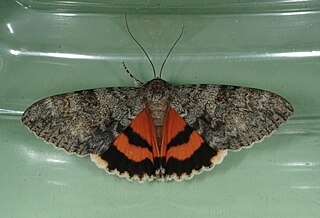
Catocala amatrix, the sweetheart underwing, is a moth of the family Erebidae. The species can be found from Nova Scotia, south through Connecticut to Florida and west through Texas and Oklahoma to Arizona and north to Montana, Minnesota, and Ontario.

Catocala retecta, the yellow-gray underwing, is a moth of the family Erebidae. The species was first described by Augustus Radcliffe Grote in 1872. It can be found in North America from southern Ontario and Quebec south through Maine and New Jersey, south through Tennessee to Georgia and west to Arkansas and Kansas and north to Wisconsin. There is one recognised subspecies, Catocala retecta luctuosa, which is sometimes treated as a valid species with the common name yellow-fringed underwing.

Catocala meskei, or Meske's underwing, is a moth of the family Erebidae. The species was first described by Augustus Radcliffe Grote in 1873. It is found in North America from Maine and Quebec west to southern Alberta and Montana, south to South Carolina in the east and at least Montana in the west.
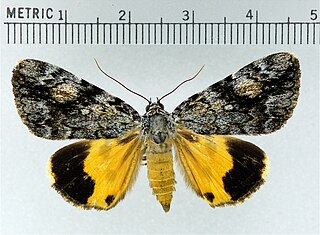
Catocala amica, the girlfriend underwing, is a moth of the family Erebidae. The species was first described by Jacob Hübner in 1818. It is found from southern Canada through the United States east of the Rocky Mountains, ranging westward to Oklahoma and Arizona, northward to Minnesota and southwestward to Texas.

Catocala blandula, the charming underwing, is a moth of the family Erebidae. The species was first described by George Duryea Hulst in 1884. It is found in North America from Nova Scotia west to central Alberta, south to Pennsylvania and Wisconsin.
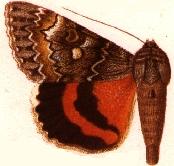
Catocala briseis, the Briseis underwing or ribbed underwing, is a moth of the family Erebidae. The species was first described by William Henry Edwards in 1864. It is found across the North American Boreal forest region from Newfoundland to the Pacific, south to Massachusetts and Pennsylvania.
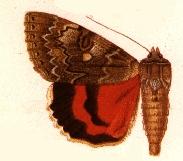
Catocala californica is a moth of the family Erebidae first described by William Henry Edwards in 1864. It is found in western North America from British Columbia and Alberta south through Washington and Oregon to California.

Catocala hermia, the Hermia underwing, is a moth of the family Erebidae. The species was first described by Henry Edwards in 1880. It is found throughout the Great Plains of North America, from southern Saskatchewan and Alberta south and west to Texas, Arizona and California.

Catocala junctura, the joined underwing or Stretch's underwing, is an moth in the family Erebidae. The species was first described by Francis Walker in 1858. It is found throughout temperate North America ranging from New York and Pennsylvania west to Montana, Colorado, Oklahoma, Arizona and into Texas, and north to southern Illinois, extreme southern Alberta and Saskatchewan; it has also been recorded west of the Rocky Mountains from California and south-eastern British Columbia. It is typically found near water, where the food plants of its caterpillar larvae grow plentifully.
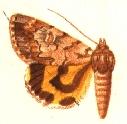
Catocala praeclara, the praeclara underwing, is a moth of the family Erebidae. The species was first described by Augustus Radcliffe Grote and Coleman Townsend Robinson in 1866. It is found in North America from Nova Scotia west to south-eastern Alberta, south to Florida and Kansas.
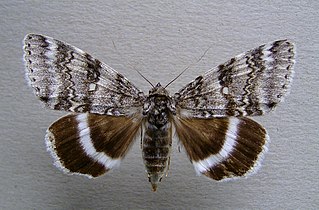
Catocala relicta, the white underwing or relict, is a moth of the family Erebidae. The species was first described by Francis Walker in 1858. It is found in southern Canada, from Newfoundland to Vancouver Island, south to Missouri, and Arizona.

Catocala semirelicta, the semirelict underwing, is a moth of the family Erebidae. The species was first described by Augustus Radcliffe Grote in 1874. It is found in North America from Nevada, Colorado, Utah, California, and Nova Scotia south to Maine, west across Canada to British Columbia, and southward in the mountains.
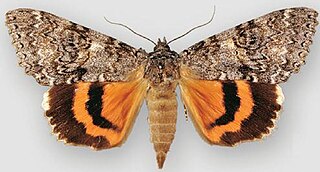
Catocala unijuga, the once-married underwing, is a moth of the family Erebidae. The species was first described by Francis Walker in 1858. It is found in North America from Newfoundland west to south central British Columbia, south to Kentucky and Missouri in the east, Colorado and Utah in the west.
Catocala pretiosa, the precious underwing, is a moth of the family Erebidae. The species was first described by Joseph Albert Lintner in 1876. It was included in Catocala crataegi by many authors, but recently it has been revalidated as a distinct species. The subspecies of pretiosa is listed as a species of special concern and believed extirpated in the US state of Connecticut.













